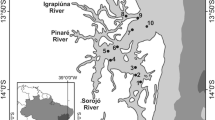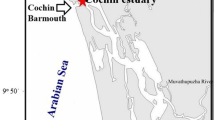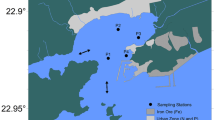Abstract
Fish mortality and hypoxic events occur in many coastal and inland systems and may result from natural or anthropogenically mediated processes. The effects of consequent changes in water biogeochemistry have been investigated for communities of benthic invertebrates and pelagic metazoans. The responses of micro-plankton assemblages, however, have remained largely unstudied. The northern basin of King Harbor, a small embayment within Santa Monica Bay, CA, USA, suffered a massive fish kill in March 2011 as a consequence of acute hypoxia. Dissolved oxygen concentrations < 0.1 ml l−1 were measured in the northern basin of the harbor for several days following the mortality event, and a strong spatial gradient of oxygen was observed from the northern basin to waters outside the harbor. The microplankton community within King Harbor differed significantly from a diatom-dominated community present in neighboring Santa Monica Bay. The latter region appeared unaffected by physicochemical changes, induced by the fish kill, that were observed within the harbor. A trophic shift was observed throughout King Harbor from a photoautotrophic-dominated assemblage to one of heterotrophic forms, with relative abundances of bacterivorous ciliates increasing by more than 80 % in the most impacted part of the harbor. Significant changes in community structure were observed together with dramatically reduced photosynthetic yield of the remaining phytoplankton, indicating severe physiological stress during the extreme hypoxia.








Similar content being viewed by others
References
Arar, E.J., and G.B. Collins. 1997. In vitro determination of chlorophyll a and pheophytin a in marine and freshwater algae by fluorescence. US Environmental Protection Agency, Cincinnati: National Exposure Research Laboratory Office of Research and Development.
Backer, L.C. 2009. Impacts of Florida red tides on coastal communities. Harmful Algae 8(4): 618–622.
Barboza, T., and K.R. Weiss. 2011. Redondo Beach fish die-off: tests show oxygen levels at ‘almost zero’. Los Angeles: Los Angeles Times.
Bell, G.W., and D.B. Eggleston. 2005. Species-specific avoidance responses by blue crabs and fish to chronic and episodic hypoxia. Marine Biology 146(4): 761–770.
Bograd, S.J., C.G. Castro, E. Di Lorenzo, D.M. Palacios, H. Bailey, W. Gilly, and F.P. Chavez. 2008. Oxygen declines and the shoaling of the hypoxic boundary in the California Current. Geophysical Research Letters 35(12): L12607.
Borics, G., I. Grigorszky, S. Szabó, and J. Padisák. 2000. Phytoplankton associations in a small hypertrophic fishpond in East Hungary during a change from bottom-up to top-down control. Hydrobiologia 424(1): 79–90.
Boullion, T.L. 1985. The effect of summer hypoxia on plankton density and community structure off the Louisiana coast. American Zoologist 25(4): A10-A10.
Bray, J.R., and J.T. Curtis. 1957. An ordination of the upland forest communities of southern Wisconsin. Ecological Monographs 27: 325–349.
Britto, D.T., and H.J. Kronzucker. 2002. NH +4 toxicity in higher plants: a critical review. Journal of Plant Physiology 159: 567–584.
Clarke, K.R., and R.M. Warwick. 2001. Change in marine communities: an approach to statistical analysis and interpretation, 2nd ed. UK: PRIMER-E, Plymouth.
Cohen, Y., B.B. Jørgensen, N.P. Revsbech, and R. Poplawski. 1986. Adaptation to hydrogen sulfide of oxygenic and anoxygenic photosynthesis among cyanobacteria. Applied and Environmental Microbiology 51(2): 398–407.
Colwell, R.K. 2009. EstimateS: statistical estimation of species richness and shared species from samples. Version 8.2. User's guide and application.
Corcoran, A.A., and R.F. Shipe. 2011. Inshore–offshore and vertical patterns of phytoplankton biomass and community composition in Santa Monica Bay, CA (USA). Estuarine, Coastal and Shelf Science 94: 24–35.
Diaz, R.J., and R. Rosenberg. 1995. Marine benthic hypoxia: a review of its ecological effects and the behavioural responses of benthic macrofauna. Oceanography and Marine Biology: An Annual Review 33: 245–303.
Diaz, R.J., and R. Rosenberg. 2008. Spreading dead zones and consequences for marine ecosystems. Science 321(5891): 926–929.
Eby, L.A., and B. Crowder. 2002. Hypoxia-based habitat compression in the Neuse River Estuary: context-dependent shifts in behavioral avoidance thresholds. Canadian Journal of Fisheries and Aquatic Sciences 59(6): 952–965.
Eby, L.A., and L.B. Crowder. 2004. Effects of hypoxic disturbances on an estuarine nekton assemblage across multiple scales. Estuaries 27(2): 342–351.
Falkowski, P.G., and J.A. Raven. 2007. Aquatic photosynthesis, 2nd ed. Princeton: Princeton University Press.
Fenchel, T., L.D. Kristensen, and L. Rasmussen. 1990. Water column anoxia: vertical zonation of planktonic protozoa. Marine Ecology Progress Series 62: 1–10.
Fenchel, T.O.M., T.E.D. Perry, and A. Thane. 1977. Anaerobiosis and symbiosis with bacteria in free-living ciliates. Journal of Eukaryotic Microbiology 24(1): 154–163.
Gannon, D.P., E.J.B. McCabe, S.A. Camilleri, J.G. Gannon, M.K. Brueggen, A.A. Barleycorn, V.I. Palubok, G.J. Kirkpatrick, and R.S. Wells. 2009. Effects of Karenia brevis harmful algal blooms on nearshore fish communities in southwest Florida. Marine Ecology Progress Series 378: 171–186.
Gasol, J.M., J. García-Cantizano, R. Massana, R. Guerrero, and C. Pedrós-Alió. 1993. Physiological ecology of a metalimnetic Cryptomonas population: relationships to light, sulfide and nutrients. Journal of Plankton Research 15(3): 255–275.
Goodman, J.L., K.A. Moore, and W.C. Dennison. 1995. Photosynthetic responses of eelgrass (Zostera marina L.) to light and sediment sulfide in a shallow barrier island lagoon. Aquatic Botany 50(1): 37–47.
Grantham, B.A., F. Chan, K.J. Nielsen, D.S. Fox, J.A. Barth, A. Huyer, J. Lubchenco, and B.A. Menge. 2004. Upwelling-driven nearshore hypoxia signals ecosystem and oceanographic changes in the northeast Pacific. Nature 429(6993): 749–754.
Gray, J.S., R.S.-S. Wu, and Y.Y. Or. 2002. Effects of hypoxia and organic enrichment on the coastal marine environment. Marine Ecology Progress Series 238: 249–279.
Hötzel, G., and R. Croome. 1999. A phytoplankton methods manual for Australian freshwaters, 58. Canberra: Land and Water Resources Research and Development Corporation.
Johannes, R.E. 1965. Influence of marine protozoa on nutrient regeneration. Limnology and Oceanography 10(3): 434–442.
Jones, R.J., and O. Hoegh-Guldberg. 2001. Diurnal changes in the photochemical efficiency of the symbiotic dinoflagellates (Dinophyceae) of corals: photoprotection, photoinactivation and the relationship to coral bleaching. Plant, Cell & Environment 24(1): 89–99.
Kemp, W.M., W.R. Boynton, J.E. Adolf, D.F. Boesch, W.C. Boicourt, G. Brush, J.C. Cornwell, T.R. Fisher, P.M. Glibert, J.D. Hagy, L.W. Harding, E.D. Houde, D.G. Kimmel, W.D. Miller, R.I.E. Newell, M.R. Roman, E.M. Smith, and J.C. Stevenson. 2005. Eutrophication of Chesapeake Bay: historical trends and ecological interactions. Marine Ecology Progress Series 303: 1–29.
Kolber, Z., and P.G. Falkowski. 1993. Use of active fluorescence to estimate phytoplankton photosynthesis in situ. Limnology and Oceanography 38(8): 1646–1665.
La, V.T., and S.J. Cooke. 2011. Advancing the science and practice of fish kill investigations. Reviews in Fisheries Science 19(1): 21–33.
Levin, L.A. 2003. Oxygen minimum zone benthos: adaptation and community response to hypoxia. Oceanography and Marine Biology: An Annual Review 41: 1–45.
Lowe, J.A., D.R.G. Farrow, A.S. Pait, S.J. Arenstam, E.F. Lavan. 1991. Fish kills in coastal waters 1980–1989. Strategic Environmental Assessments Division, Office of Ocean Resources Conservation and Assessment, National Ocean Service, National Oceanic and Atmospheric Administration.
Marcus, N.H. 2001. Zooplankton: responses to and consequences of hypoxia. In Coastal hypoxia: conseqences for living resources and ecosystems, ed. N.N. Rabalais and R.E. Turner. Washington DC: American Geophysical Union.
Marti-Cardona, B., T.E. Steissberg, S.G. Schladow, and S.J. Hook. 2008. Relating fish kills to upwellings and wind patterns in the Salton Sea. Hydrobiologia 604: 85–95.
McInnes, A.S., and A. Quigg. 2010. Near-annual fish kills in small embayments: casual vs. causal factors. Journal of Coastal Research 26(5): 957–966.
Meehl, G.A., T.F. Stocker, W.D. Collins, P. Friedlingstein, A.T. Gaye, J.M. Gregory, A. Kitoh, R. Knutti, J.M. Murphy, A. Noda, S.C.B. Raper, I.G. Watterson, A.J. Weaver, and Z.-C. Zhao. 2007. Global climate change projections. In Climate change 2007: the physical science basis. Contribution of Working Group I to the Fourth Assessment Report of the Intergovernmental Panel on Climate Change, ed. S. Solomon, D. Qin, M. Manning, Z. Chen, M. Marquis, K.B. Averyt, M. Tignor, and H.L. Miller. Cambridge: Cambridge University Press.
Orrico, C.M., C. Moore, D. Romanko, A. Derr, A.H. Barnard, C. Janzen, N. Larson, D. Murphy, R. Johnson, J. Bauman. 2007. WQM: a new integrated water quality monitoring package for long-term in-situ observation of physical and biogeochemical parameters. Oceans 2007 MTS/IEEE, Vancouver.
Palsson, W.A., R.E. Pacunski, T.R. Parra, and J. Beam. 2008. The effects of hypoxia on marine fish populations in southern Hood Canal, Washington. Mitigating Impacts of Natural Hazards on Fishery Ecosystems 64: 255–280.
Poertner, H.O., and M.A. Peck. 2010. Climate change effects on fishes and fisheries: towards a cause-and-effect understanding. Journal of Fish Biology 77(8): 1745–1779.
Ptacnik, R., U. Sommer, T. Hansen, and V. Martens. 2004. Effects of microzooplankton and mixotrophy in an experimental planktonic food web. Limnology and Oceanography 49(4): 1435–1445.
Rodriguez, N., and O. Duran. 2010. Monthly bigeye tuna catches forecasting using wavelet functional autoregression. Los Alamitos: IEEE Computer Soc.
Rzepka, A., J. Krupa, and I. Lesak. 2005. Effect of hypoxia on photosynthetic activity and antioxidative response in gametophores of Mnium undulatum. Acta Physiologiae Plantarum 27(2): 205–212.
Simpson, E.H. 1949. Measurement of diversity. Nature 163: 688.
Stachowitsch, M., B. Riedel, M. Zuschin, and R. Machan. 2007. Oxygen depletion and benthic mortalities: the first in situ experimental approach to documenting an elusive phenomenon. Limnology and Oceanography: Methods 5: 344–352.
Stauffer, B., A. Gellene, A. Schnetzer, E. Seubert, C. Oberg, G. Sukhatme, D. Caron. 2012. An oceanographic, meteorological and biological ‘perfect storm’ yields a massive fish kill. Marine Ecology Progress Series, in press.
Strickland, J.D.H., and T.R. Parsons. 1972. A practical handbook of seawater analysis, 2nd ed. Ottawa: Fisheries Research Board of Canada.
Thronson, A., and A. Quigg. 2008. Fifty-five years of fish kills in coastal Texas. Estuaries and Coasts 31(4): 802–813.
Utermohl, H. 1931. Neue Wege in der quantitativen Erfassung des Plankton. Verhandlungen der Internationalen Vereinigung fuer Theoretische Limnologie Stuttgart 5: 567–596.
Utermohl, H. 1958. Zur Gewassertypenfrage tropischer Seen. Verhandlungen Internationalen Vereinigung Limnologie 13(1): 236–251.
Venrick, E.L. 2002. Floral patterns in the California Current System off southern California: 1990–1996. Journal of Marine Research 60: 171–189.
Wetz, M.S., E.A. Hutchinson, R.S. Lunetta, H.W. Paerl, and J.C. Taylor. 2011. Severe droughts reduce estuarine primary productivity with cascading effects on higher trophic levels. Limnology and Oceanography 56(2): 627–638.
Wilcox, R.R. 2003. Applying contemporary statistical techniques. New York: Academic.
Wu, R.S.S. 2002. Hypoxia: from molecular responses to ecosystem responses. Marine Pollution Bulletin 45(1–12): 35–45.
Yoshino, K., T. Hamada, K. Yamamoto, Y. Hayami, S. Yamaguchi, and K. Ohgushi. 2010. Effects of hypoxia and organic enrichment on estuarine macrofauna in the inner part of Ariake Bay. Hydrobiologia 652(1): 23–38.
Zhang, H., S.A. Ludsin, D.M. Mason, A.T. Adamack, S.B. Brandt, X. Zhang, D.G. Kimmel, M.R. Roman, and W.C. Boicourt. 2009. Hypoxia-driven changes in the behavior and spatial distribution of pelagic fish and mesozooplankton in the northern Gulf of Mexico. Journal of Experimental Marine Biology and Ecology 381: S80–S91.
Acknowledgments
This work was funded by grants from the National Science Foundation (CCR-0120778), National Oceanic and Atmospheric Administration National Sea Grant College Program (NA10OAR4170058), and National Oceanic and Atmospheric Administration MERHAB Program (NA05NOS4781228). The authors would like to thank the members of the City of Redondo Beach Fire Department, the Los Angeles County Lifeguards, and the City of Redondo Beach for their assistance in site access and sample collection. The authors also acknowledge R.A. Schaffner for assistance in mapping, A.C. Jones for guidance in analyses of community structure, and E.L. Seubert, V.L. Campbell, and P.E. Connell for assistance in collection and processing of samples.
Author information
Authors and Affiliations
Corresponding author
Rights and permissions
About this article
Cite this article
Stauffer, B.A., Schnetzer, A., Gellene, A.G. et al. Effects of an Acute Hypoxic Event on Microplankton Community Structure in a Coastal Harbor of Southern California. Estuaries and Coasts 36, 135–148 (2013). https://doi.org/10.1007/s12237-012-9551-6
Received:
Revised:
Accepted:
Published:
Issue Date:
DOI: https://doi.org/10.1007/s12237-012-9551-6




